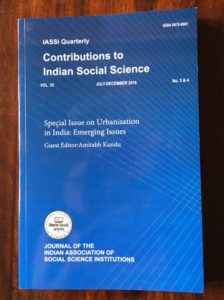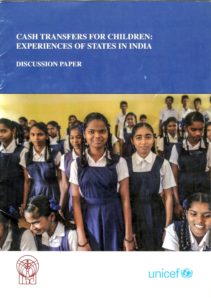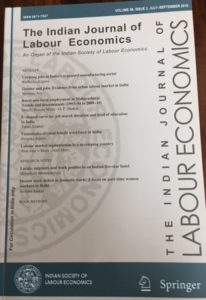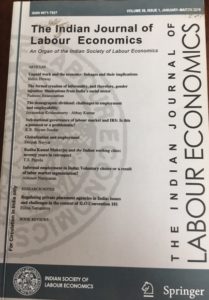1. Potential of The Manufacturing Sector To Absorb Rural Labour: A Case Study of Two Towns In Bihar
Journal of the Indian Association of Social Science Institutions : Contributions to Indian Social Science : Jul-Dec 2016 Pages 305-322: Vol 35. No 3 & 4 ISSN 0970-9061
Abstract: In the context of India’s potential demographic dividend resulting from a faster growth of the working age population vis-a-vis the total population, productive deployment of the labour force is key, since otherwise it may well give rise to adverse consequences for the society. Efforts towards absorbing the labour force available in large numbers in the country are therefore crucial. Industrialisation, with focus on manufacturing, has traditionally been the route to economic growth for many developed countries, and recently the service sector has emerged as the driver of growth among the South Asian countries including India. Whichever route is adopted for the Indian economy for moving ahead, the surplus labour, due to new entrants as well as release of workers from agriculture sector,

would have to be productively absorbed. In India, rural population forms the bulk of the total population and the majority of the total work force is still in the rural areas. One way of absorbing labour that is unemployed or underemployed in rural areas is to provide them productive employment opportunities in urban areas. The urban centres can work as a pull-factor for the surrounding rural areas through many rural-urban linkages, providing scope for absorbing workers from rural areas. It has been contended that Small and Medium Towns can play an important role in spreading urban development via rural-urban linkages. They can also provide growth impulses to surrounding rural hinterland through material linkages (backward and forward), especially in manufacturing activities. In this context, the paper examines the sources of urban output and growth as well as rural-urban linkages in terms of employment and input-output in two towns in Bihar, using detailed enterprise surveys. It was found that although the manufacturing sector shows the strongest rural-urban linkages compared to other sectors such as retail or trade or other services, making it the sector with the maximum potential to create employment for absorbing the surplus labour in the rural areas, this sector has been languishing in the sample towns and is constrained by severe infrastructure bottlenecks, among other constraints.
2. English-Medium Low-Cost Private Schools: How Are the Children Learning?
Indian Journal of Human Development, Jul-Dec 2015 Vol 9. No 2. ISSN 09737030
Abstract: The increasing demand for schooling in India is being met largely by private schools. Private schools vary in terms of the fees charged and the quality of education imparted. In the low-cost private schools in particular, a marketing strategy to attract students has been to advertise the medium of

instruction as English. Anecdotal evidence indicates that children from relatively low socio-economic status are often sent to attend such English-medium low-cost private schools, to fulfil the parent’s ambition for an English-medium education, and that these children mostly have parents with low educational levels who also have little exposure to English at home. In addition, for the same reasons, they spend on private tuition out of their limited income. English medium schools of the low cost variety in India are sometimes regarded as filling a gap in demand since they provide English-medium education to the disadvantaged segments of the society, thus leading to reduced social inequality. However, if the quality of learning is poor not only in the English language, but also in other subjects that are taught in the English medium, thus adversely impacting the foundation of education for the children concerned, then that phenomenon needs to be highlighted so that a process of rectification can be set in motion. It also brings in the added danger of jeopardising the quality of learning in the vernacular language, since it is relatively neglected. It is thus important to gain insight into this mode of education delivery on which little information is available, especially in the interest of social equity.
3. Cash Transfers For Children: Experiences Of States In India – A IHD-UNICEF Discussion Paper
Paper developed by: Tanuka Endow (Indian Institute of Human Development, T.V. Sekher (International Institute for Population Sciences), Antara Lahiri (UNICEF)
For National Workshop on Cash Transfers for Children – Dec 2015
Background:
“Social protection is the set of public and private policies and programmes aimed at preventing, reducing and elimination economic and social vulnerabilities to poverty and deprivation”
UNICEF Social Protection Strategic Framework, 2012
In the last few decades, governments across the world have introduced social protection programmes as a way of ensuring that the benefits of economic growth reach the poorest and most marginalised communities. This global interest is reflected in the inclusion of social protection in several targets of the Sustainable Development Goals.

Through its positive impacts on education, nutrition, health and protection, social protection in the form of cash transfers can support children’s development well beyond childhood and contribute to breaking the inter-generational cycle of poverty. This is important as inter-generational poverty has long term effects on children in various ways. For instance, poverty during childhood is strongly associated with malnutrition, lower school attendance, lower educational accomplishment, higher dropouts and consequent decrease in future productive capacity.
Experiences from across the world indicate that cash transfers are an innovative and increasingly popular channel for the delivery of social protection. Many governments have implemented cash transfer programmes as a means of reducing social and economic inequalities and enhance human capabilities. Cash transfer schemes use monetary payments to incentivise certain behaviours for promoting, amongst other things, institutional births, utilisation of health services, enrolment and attendance in school. Cash transfer programmes can be differentiated by their degree of conditionality into unconditional cash transfers (UCTs) and conditional cash transfers (CCTs). UCTs have no conditions beyond a broadly defined eligibility category that defines a segment of the population as eligible. CCTs make monetary payments to poor families contingent upon certain verifiable actions, usually involving minimum investments in children’s regular school attendance or basic preventive healthcare.
Most cash transfer schemes in India meant for children and women seek to incentivise access to basic social services such as health care, education and skill development. The girl child schemes in particular are designed to promote gender equality, ensure higher school enrolment and retention, as well as prevent child marriage. Though of recent origin, they are gaining in popularity. For instance, improvements in access to banking facilities and the spread of computer and internet facilities across and rural areas have enabled online enrolment of beneficiaries and computerisation of schemes as well as direct transfer of the money to the bank accounts of the beneficiaries. These changes are reflected in the move of the government towards the ‘JAM Trinity’ (JAM is an abbreviation for Jan Dhan Yojna, Adhaar and Mobile number). The trinity is expected to promote direct cash transfers: with Adhaar providing a unique identity number backed by bimetric identification of beneficiaries, Jan Dhan Yojna opening bank accounts, and mobile phones allowing direct transfers of funds into their accounts.
Against this backdrop, this study seeks to: share good practices in the administration of cash transfer schemes for children in India (including identification of beneficiaries, financing, delivery, monitoring and evaluation, coordination, and covering the last mile), understand constraints faced by State Governments in implementing such schemes, identify experiences in addressing these constraints and point to opportunities for improving their efficiency and effectiveness.
4. Book Review: Shyam Sundar K. R: Labour law and governance reforms in India; Some Critical Perspectives — Synergy Books India, New Delhi
Indian Journal of Labour Economics, Jul-Sep 2015 Vol 58 Issue 3. ISSN: 0971-7927, Associate Editor: Tanuka Endow
Book Review By: Sanjay Upadhyay, Tanuka Endow

Vol 58 Issue 3, Jul-Sep 2015
ISSN: 0971-7927
Brief: The past few years have witnessed significant changes in the area of the economy and the labour market at the global as well as at the national levels. These changes have necessitated appropriate policy reforms, particularly in institutions and mechanisms pertaining to labour market regulation so as to balance the claims and challenges of both industry and the workers. There are a number of contentious issues related to such reforms which need to be duly addressed at the level of policy to proceed further in this direction. It is in this context, that Prof. Shyam Sundar has ventured this timely and extremely contemporary publication covering all relevant aspects related to the broad theme covered by the book.
5. Indian Journal of Labour Economics
Jan-Mar 2015 Vol 58 Issue 1. ISSN: 0971-7927
Associate Editor: Tanuka Endow

Vol 58 Issue 1, Jan-Mar 2015
ISSN: 0971-7927
The Indian Journal of Labour Economics, a quarterly peer reviewed journal of the Indian Society of Labour Economics, Being published since 1957, is only of its kind in South Asia which provides a forum for economists, other social scientists and professionals interested and working in labour issues. It includes scholarly articles, research notes and perspectives on labour markets, employment, industrial relations, personnel economics, political economy of labour etc., on theoretical, applied as well as policy aspects, particularly in the context of India and other developing countries. Aimed at promoting scientific studies in labour economics, the journal does not subscribe to any particular view or ideology and welcomes all streams of opinions.
6. Times of India: Dec 2, 1996
Myths about life expectancy & income
TOI_Dec 2_1996

